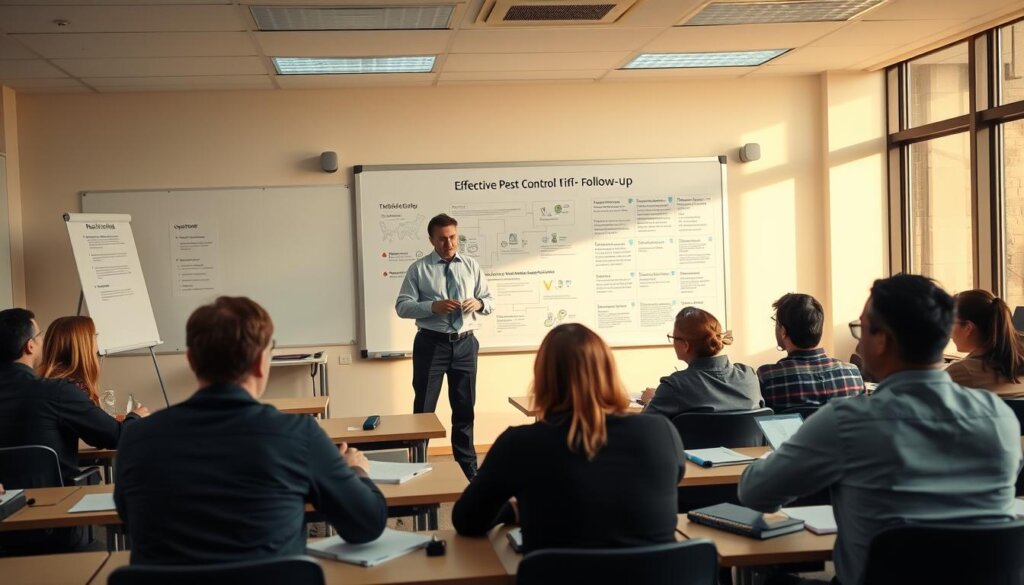Did you know that nearly 70% of customers who feel engaged with a company are more likely to stay loyal? In pest control, Customer Follow-Up is very important. It makes customers happy and helps improve service and pest management.
Following up with customers is more than just a routine. It’s about building strong relationships and making customers feel important.
In this article, we’ll talk about why pest control customer follow-up is so important. We’ll see how teaching staff and customers about these steps helps. This is key for great service and keeping things clear during pest management.

Key Takeaways
- Engagement drives customer loyalty; follow-ups are key.
- Effective follow-ups enhance service quality in pest management.
- Education for staff and clients strengthens follow-up processes.
- Proactive communication builds long-lasting customer relationships.
- Customer satisfaction is significantly affected by follow-up practices.
The Importance of Follow-Up in Pest Control Services
Follow-up is key in pest management. After services, clients might have questions or worries. By checking in, I show I care and listen.
This makes them trust and like my services more. It’s important for keeping good relationships with customers.
Follow-up also helps keep clients coming back. When they feel I care about their happiness, they stay loyal. I use their feedback to get better at what I do.
This way, I keep their homes safe from pests and build my good name as a pest control expert.
Enhancing Customer Satisfaction Through Follow-Up
In the pest control world, following up after service is key. It helps me see how happy my clients are. This makes sure their needs were met.
It shows them they matter and are heard. This builds trust and makes them feel valued.
Quick follow-ups solve problems and improve how clients see our service. When I talk to clients, it shows I care about their happiness. I’m ready to help with any issues.
This makes our service stand out. It turns one-time clients into loyal friends.
By focusing on follow-ups, we gain loyal customers. Happy clients share their good experiences with others. They also come back for more.
Pest Control Customer Follow-Up: Effective Strategies
Keeping strong ties with clients is key in pest control. Follow-up timing and personalized messages are vital. They boost satisfaction and trust.
Timing Your Follow-Ups
Setting a follow-up schedule is important. I suggest contacting clients a week after the first service. This keeps their experience fresh.
Regular checks help keep satisfaction high. They also solve any remaining issues quickly. This shows you care and value their business.
Personalizing Communication
Personalized messages are crucial for good follow-ups. Mentioning specific pest problems helps a lot. It builds trust and connection.
Using these methods makes customers happier. It also keeps them loyal to your service.
Understanding Customer Expectations
In pest control, knowing what customers want is key. Many think pest control fixes problems forever. So, I must be clear about what I can do.
I tell clients about the hard work of keeping pests away. I explain that sometimes pests come back and more treatments might be needed. This helps build trust and strong relationships.
I aim to meet customer needs by being open and honest. When customers know what to expect, they’re happier. This makes my pest control services seem reliable and trustworthy.

Best Practices for Follow-Up Procedures
In pest control, *best practices* for follow-up are key. They make customers feel important and heard. A good plan helps everything run smoothly and builds strong client relationships.
A clear process means you can talk to customers on time. This makes them more likely to stay with you.
Establishing a Systematic Approach
Having a plan for follow-ups is very important. I organize my schedule to fit what clients want and how they like to talk. This makes them happier.
Staying regular with clients helps a lot. It reminds them of what you did and if they need more help.
Tracking Customer Interactions
It’s important to keep track of how you talk to customers. I use systems to remember what each client needs. This helps me see if they’re happy and how to talk to them better next time.
When clients feel heard, they trust you more. This is good for your business.
Utilizing Technology for Effective Follow-Up
Using technology in pest control makes my follow-up work better. I use pest control software to keep track of customer info and stay in touch. It sends out reminders, saving me time and keeping clients on schedule.
This helps build a good relationship with my customers. It shows I care about their needs.
Data helps me understand pest patterns and how customers interact. This lets me give solutions that fit their problems. It shows I’m serious about helping them.
When customers feel supported, they’re happier with my service. This makes them more likely to choose me again.
Building Trust with Ongoing Communication
In my experience, building trust with clients is key. It comes from ongoing communication. I make sure to talk openly with those who need pest control services.
Regular updates after treatment help a lot. They tell customers about their pest situation. They also show we care about their happiness.
By checking in often, I show I care about clients’ well-being. I give extra tips on pest prevention and answer questions fast. This makes clients feel important and heard.
Training Staff on Effective Follow-Up Techniques
Good follow-up is key to pest control success. I make sure my team knows how to do it right. They learn to talk to customers well and follow up right.
This makes customers happy and shows they’re getting great service.
Role-Playing Scenarios for Better Engagement
Role-playing helps my team get better at follow-ups. They practice talking to customers in different situations. This makes them more confident and understand what customers need better.
It’s a great way to learn how to connect with clients in a positive way.

Monitoring Outcomes of Follow-Up Interactions
It’s very important to watch how follow-up talks go in the pest control world. I see that knowing if these talks work well can really make customers happy. When I listen to what people say after we talk, I can find things to get better at.
This helps me fix any problems, making our relationship stronger. It’s all about making sure our clients are happy and feel heard.
For me, keeping an eye on how follow-up talks do means I can change my pest control plans. Every talk gives me clues about how happy my customers are and how well I’m doing. By checking these results, I make sure my clients feel important and valued. This makes them loyal and helps us work together for a long time.
Integrating Feedback into Your Follow-Up Strategy
Getting feedback from customers is key to making my follow-up strategy better. It helps me understand what customers like and what I can do better. Using customer surveys lets me know how well I’m doing and what I can improve on.
Utilizing Customer Surveys
Customer surveys are very helpful. They let me ask clients about their thoughts and feelings. By asking the right questions, I learn what they like and what needs work.
This feedback helps me make my follow-up strategy even better. Making changes based on what I learn makes my services better. It also helps keep customers happy and loyal.
Utilizing Multiple Channels for Customer Communication
In the fast world of pest control, talking to customers is key. I know people like to talk in different ways. So, I use phone calls, emails, and SMS to reach everyone.
Using old and new ways to talk is important. It makes sure I can talk to clients easily and quickly. When I’m easy to reach, clients feel important and heard.
Conclusion
Effective customer follow-up is key in pest control services. It makes customers feel valued and understood. This way, we can make them happy and keep them coming back.
Using good follow-up strategies helps a lot. It makes customers see we care about them. This builds trust and makes them believe in us.
I want everyone in pest control to work on their follow-up plans. This shows we care about quality and want to be the best. Let’s make sure our customers know we’re here for them.
See how FieldAx can transform your Field Operations.
Try it today! Book Demo
You are one click away from your customized FieldAx Demo!
FAQ
Why is follow-up important after pest control services?
Follow-up is key because it builds trust and makes customers happy. It also fixes any problems after treatment. It shows you care about quality and want to keep pests away for good.
How can effective follow-up improve customer retention?
Good follow-up makes customers feel valued and loyal. It shows you’re always there for them. This leads to more referrals and coming back for more services.
What strategies can pest control companies use for effective follow-up?
To follow up well, check in a week after service. Talk about the specific pest problems you solved. Keep in touch regularly to keep customers happy.
How can technology assist in the follow-up process?
Technology helps a lot. Use CRM systems, reminders, and digital chats. This way, you can quickly meet customer needs and keep track of your interactions.
What role does staff training play in follow-up procedures?
Training is very important. It teaches staff how to talk to customers and what to expect. Role-playing helps them handle customer concerns better, making your service better.
How can feedback from follow-up interactions be used for improvement?
Use feedback to find ways to get better. Adjust your plans based on what customers say. This makes your service better and keeps customers happy.
Why is it essential to understand customer expectations in pest control?
Knowing what customers expect helps you meet their needs. Explain how pest control works and the chance of pests coming back. This builds trust and a strong service relationship.
What communication channels are best for effective follow-up?
Use different ways to talk to customers like phone calls, emails, and texts. This way, you reach everyone and keep in touch regularly. It makes customers happy and keeps them coming back.
Author Bio
Co-Founder & CMO at Merfantz Technologies Pvt Ltd | Marketing Manager for FieldAx Field Service Software | Salesforce All-Star Ranger and Community Contributor | Salesforce Content Creation for Knowledge Sharing





